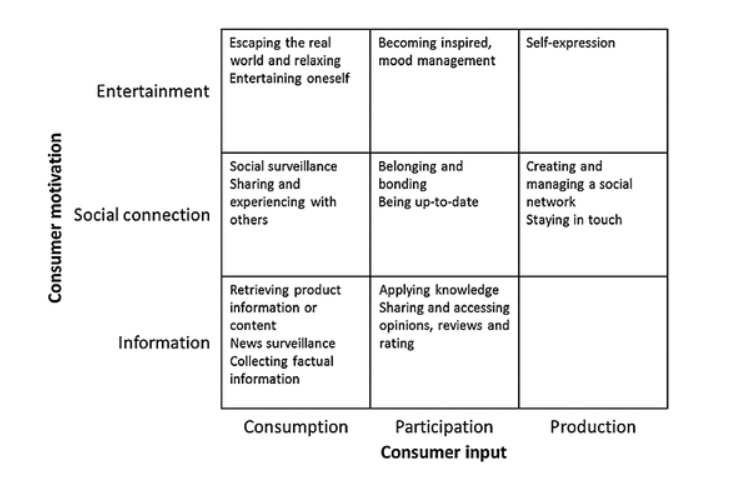The evolution of the internet has changed the way people consume information on different kinds of devices. Social media has become an integral part in terms of new content consumption. Organizations and individuals today have their own page on different platforms. Competition is much more unpredictable and fiercer. Consumer behavior on social media changes frequently and hence it is important for organizations to keep up with changing trends.
Kristina Heinonen in her paper published in the Journal of Consumer behavior (2011) discusses the motivation behind the changing consumer behavior on social media platforms. She developed a conceptual framework for consumers narratives on their social media activity.

The activities were categorized based on consumer inputs and consumer motives as seen in the figure above. The 15 social media activities emerged were divide into 3 categories depending on the motivation level of the consumers. This model helps understand the major reasons why so much content is consumed on the internet.

The author also added another framework above that helps organization segregate ways in which it wants to target its customers and what kind of content is required based on consumer preference. This can help form strategies to increase social media engagement, improve product awareness with a lot of fresh content.

Zomato is an Indian restaurant search platform and discovery service found in 2008 and currently operate in 24 countries worldwide including Australia.
Using the above framework, I was able to conclude that Zomato’s target consumer wish to apply knowledge, share opinions and reviews as seen in Figure 1 and fall under the participation and information grid. Hence for Zomato,it was clear it needed to create a platform for its customers to give real-time review, share pictures and create a social media platform where food bloggers and so-called foodies can express their love for food.
Zomato has a very diverse type of business model to earn revenue and keep the social aspect as well. Zomato uses Community Model which is based on user loyalty, the more you review restaurants and add photos the more points and levels you gain. You can also connect with other users on the platform. Apart from that restaurants advertise on Zomato through a pay-per-click method that generates revenue based on the number of clicks. Recently Zomato also started a Subscription-based model in Australia called Zomato Gold that charges a semi-annual fee of 39AUD and an annual subscription of 59AUD. With this membership, users can now get a dish free with a dish they order and every two drinks free for every two drinks purchased.

Source: Snapshot of my personal Zomato account. Follow me !!!!!
All in all, Zomato has a very robust mobile application and website that keeps like-minded people on one platform and share opinions and reviews on the food. It provides food delivery service and different offers for people dining out as well.
Food bloggers will not only blog on Zomato about the restaurants visited but also share their opinion and photographs on other platforms like Instagram and Facebook. Consumers on social media prefer information before using any product or service. Hence nowadays it has become important that such platforms help promote new services and products but also get customer reviews from experts before trying it out.
Consumers on social media are very opinionated and have strong views hence for organizations to have the right strategy in place to understand how consumers react before going public with any information is crucial.
Do you think organizations will ever be able to predict the way consumers react to information shared over social media? What more do you think organizations can do to help with this dilemma?
